Birdfinding.info ⇒ The southern form of Saffron Finch is widespread and common across much of South America from Bolivia and southern Brazil to central Argentina. Some heavily visited areas where it is locally abundant include the Pantanal of Mato Grosso and several major urban areas including Buenos Aires, Montevideo, and São Paulo.
“Pelzeln’s Yellow-Finch”
Sicalis flaveola pelzelni
Central and southern South America, from northern Bolivia and central Brazil east to Rio de Janeiro and south to central Argentina.
The northernmost populations occur in savannas of northern Bolivia, Rondônia, Mato Grosso, and western Goiás, and at least locally up the eastern slopes and interior valleys of the Andes to the vicinities of La Paz and Cochabamba.

Approximate distribution of Saffron Finch, including “Pelzeln’s Yellow-Finch”. © BirdLife International 2018
From those areas, it occurs southward through the savanna regions of South America and lower and middle elevations of the eastern Andes (locally up to at least 3,100 m), south through the interior of Argentina to western Río Negro, and along the coast from Rio de Janeiro to Chubut (to Trelew).
In central and eastern Brazil, “Pelzeln’s” overlaps broadly with “Saffron Finch” (brasiliensis), and the relationship between the two forms is unclear. They appear to occur side-by-side—and may interbreed freely (this seems likely but apparently is not well-documented)—over a zone of blended populations between pure pelzelni in the southwest and pure brasiliensis in the northeast. As a result, it is difficult to determine where the northeastern boundary of “Pelzeln’s” distribution lies. The zone of overlap extends approximately from eastern Goiás south through westernmost Minas Gerais and eastern São Paulo, then bends east to Rio de Janeiro.
An introduced population is well-established in south-central Chile from Concepción to Chiloé Island, and spreading.
Identification
A widespread, familiar Sicalis yellow-finch in which males resemble the closely-related “Saffron Finch”, but females do not. Both sexes show significant variation between tropical and subtropical populations and those of the Andes and southern temperate zone.
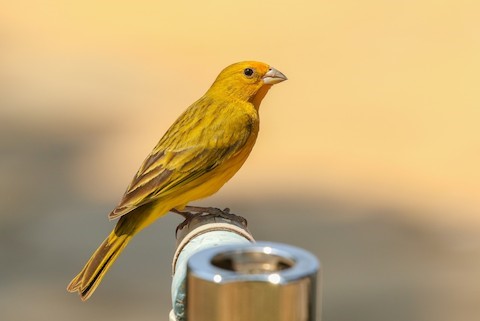
“Pelzeln’s Yellow-Finch”, S. f. pelzelni, male—bright-yellow overall, as is typical of tropical populations. (Porto Jofre, Mato Grosso, Brazil; September 9, 2019.) © Carlos Sanchez
Male Plumages. As in “Saffron Finch”, the typical male “Pelzen’s” is yellow overall with some orange on the face and forehead, olive and brown on the wings and tail, and olive-yellow with faint streaks on the back. “Pelzeln’s” differs in being on average somewhat more greenish-yellow overall, more distinctly streaked on the back, and often faintly streaked on the breast and belly.
Males of Andean and southern temperate zone populations tend to be duller overall, paler yellow below, and grayish-brown on the back, and largely blackish with yellowish-olive tones on the wings and tail. Some of these populations also include more typical-looking males, and there is a broad spectrum of intermediate appearances.

“Pelzeln’s Yellow-Finch”, S. f. koenigi, male showing largely grayish back, typical of the Andean populations. (Cachi, Salta, Argentina; August 26, 2012.) © Marco Valentini

“Pelzeln’s Yellow-Finch”, S. f. pelzelni, male in relatively dull, pale plumage. (Buenos Aires, Argentina; June 8, 2010.) © Santiago Meligeni Lozano
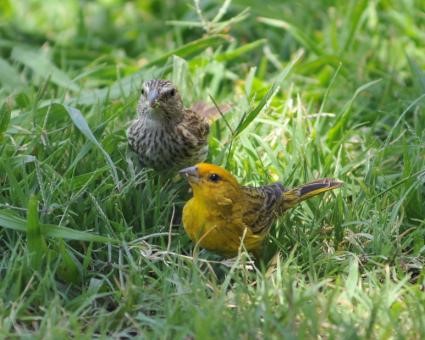
“Pelzeln’s Yellow-Finch”, S. f. pelzelni, female and male—typical of the tropical populations. (San Luís, Argentina; January 29, 2009.) © Santiago Meligeni Lozano
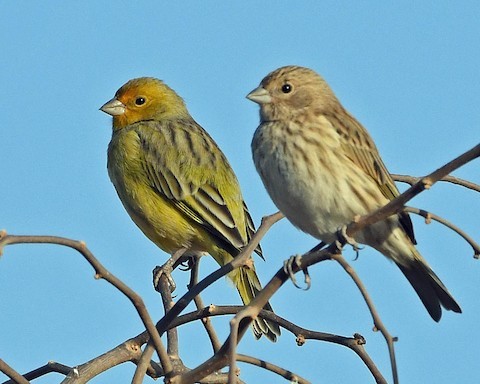
“Pelzeln’s Yellow-Finch”, S. f. koenigi, male and female—typical of the Andean populations. (El Breal, Tarija, Bolivia; July 11, 2021.) © Tini & Jacob Wijpkema
Female Plumages. Female “Pelzen’s” is brownish above, whitish below, and streaked throughout.
Most females of tropical and subtropical populations are heavily streaked, but the extent and boldness of the streaking vary. Females of Andean populations tend to be paler overall and less heavily streaked.
Female “Pelzen’s” differs fundamentally from the “Saffron” female, which resembles the male but has little or no orange on the head.

“Pelzeln’s Yellow-Finch”, S. f. pelzelni, female with bold, heavy streaking on the underparts. (40 y 108, Lavalleja, Uruguay; April 3, 2021.) © Amed Hernández
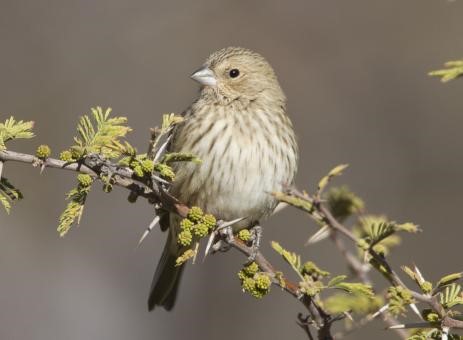
“Pelzeln’s Yellow-Finch”, S. f. koenigi, female with relatively sparse, thin streaking on the underparts. (Seclantás, Salta, Argentina; August 27, 2012.) © Marco Valentini
Immature Plumages. Juveniles generally resemble females, so immature and female plumages are not readily distinguishable.
As males age they develop yellow plumage in subtle stages but are not known to show the distinctive pattern of immature “Saffron” (mostly plain-gray with vivid yellow patches).
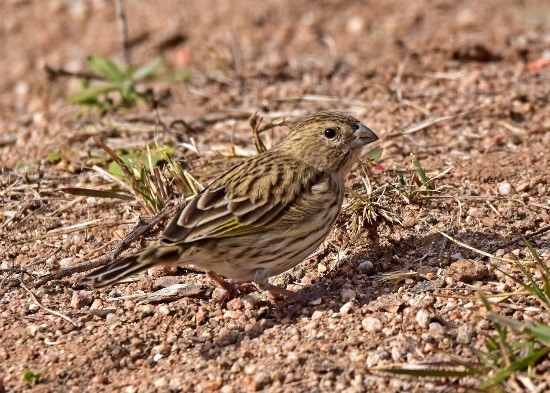
“Pelzeln’s Yellow-Finch”, S. f. pelzelni, female or immature. (Dique La Aguadita, La Rioja, Argentina; July 12, 2018.) © Carlos De Biagi
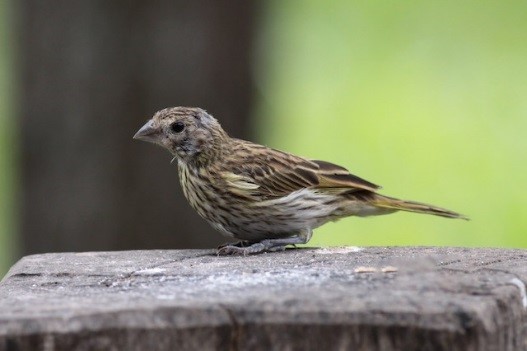
“Pelzeln’s Yellow-Finch”, S. f. pelzelni, juvenile. (Pousada Aguape, Mato Grosso do Sul, Brazil; April 6, 2010.) © Michael Todd
Notes
Polytypic form consisting of two recognized subspecies. One of two potentially distinct forms of Saffron Finch (flaveola).
See below for a discussion of the taxonomic complexity of the Saffron Finch forms and notes on separating “Pelzeln’s” from other yellow-finches.
Frontiers of Taxonomy: The Saffron Finch Complex. “Pelzeln’s Yellow-Finch” (pelzelni plus koenigi) seems to be a strong candidate for recognition as a species separate from the typical “Saffron Finch” (flaveola plus valida and brasiliensis) for the simple reason that “Pelzeln’s” is sexually dimorphic whereas “Saffron” is not. Male “Pelzeln’s” and male and female “Saffron” are all predominantly yellow and often too similar to differentiate visually, but female “Pelzeln’s” is radically different: plain gray and brown and heavily streaked. The two forms also differ in their climatic tolerances: all three subspecies of “Saffron” are exclusively tropical, whereas “Pelzeln’s” thrives from the tropics to approximately 42° South in Argentina and Chile and up to at least 3,100 m elevation in the Andes.
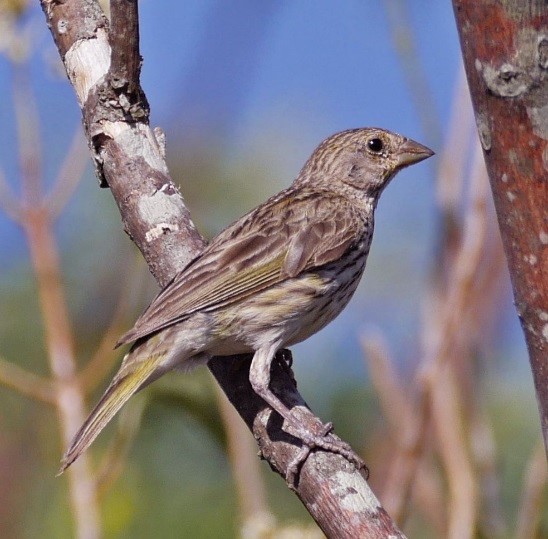
“Pelzeln’s Yellow-Finch”, S. f. pelzelni, female (or possibly an immature) showing typically plain gray-and-brown streaked appearance—entirely unlike female “Saffron”. (San Jerónimo Norte, Santa Fé, Argentina; January 21, 2018.) © Gustavo Fernando Durán
However, their songs are very similar, perhaps identical, which might make males of “Saffron” and “Pelzeln’s” equivalent as prospective mates for females of either form. Across central and southeastern Brazil, “Pelzeln’s” and “Saffron” overlap broadly across the cerrado region from Goiás to Rio de Janeiro, and in that broad zone of cohabitation the relationship between their populations is not clear. The existence of apparently intermediate individuals suggests interbreeding—which may be widespread enough to conclude that the two apparently distinct forms function naturally as a single species.
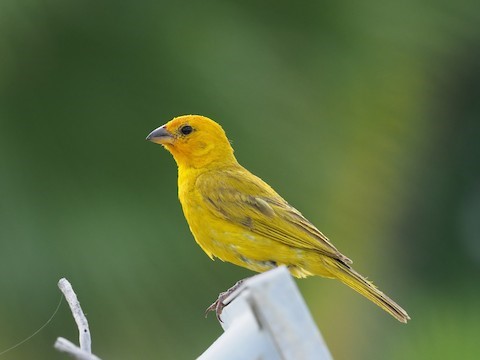
Saffron Finch, S. f. flaveola, an apparent female—which strongly resembles male “Saffron” and “Pelzeln’s”. (Saliña Bartol, Washington Slagbaai National Park, Bonaire; November 18, 2018.) © Lyle Ross
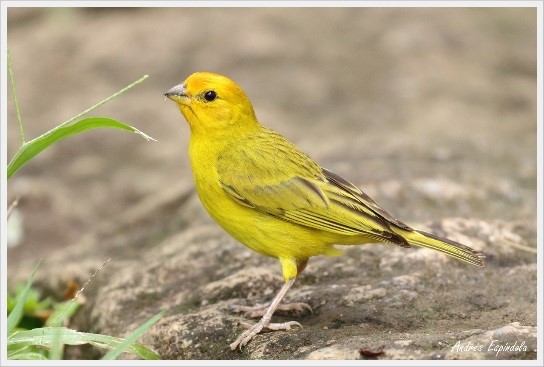
Saffron Finch, S. f. brasiliensis, an apparent female—in the zone of overlap with “Pelzeln’s Yellow-Finch”, S. f. pelzelni—and could possibly be a male pelzelni. (Parati, Rio de Janeiro, Brazil; January 29, 2018.) © Andres Espindola

Saffron Finch, S. f. brasiliensis, an apparent male—based on the amount of orange on the head. (Fazenda Porangaí, Xinguara, Pará, Brazil; September 15, 2018.) © Luiz Matos
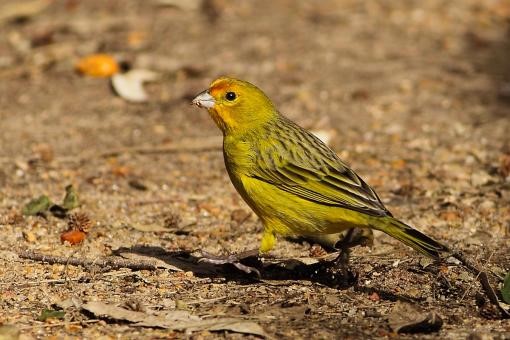
“Pelzeln’s Yellow-Finch”, S. f. pelzelni, male showing vivid plumage, with stronger streaking than typical “Saffron” males. (El Palmar National Park, Entre Ríos, Argentina; July 28, 2014.) © Cristiano Crolle
To begin, at least two factors make the evidence of interbreeding difficult to evaluate: (1) male “Pelzeln’s” strongly resembles male “Saffron” in appearance and voice and can be visually indistinguishable from the female “Saffron”, so conclusive identification of “Saffron” requires field study of groups, and is rarely possible based on photographs alone; and (2) “Pelzeln’s” varies regionally, with a progression from vivid plumage in tropical populations to plainer, grayer, and streakier plumage in temperate and montane populations, so the “Pelzeln’s” that are most similar to “Saffron” are the ones that overlap with it.
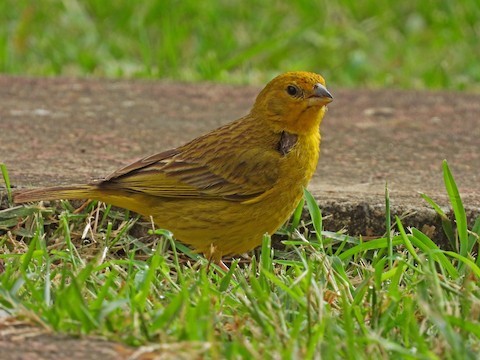
“Pelzeln’s Yellow-Finch”, S. f. pelzelni, male—in the zone of overlap with “Saffron Finch”, S. f. brasiliensis—note the streaking above and below, which seems to rule out brasiliensis. (Brasília, Brazil; May 9, 2020.) © Edvaldo Júnior
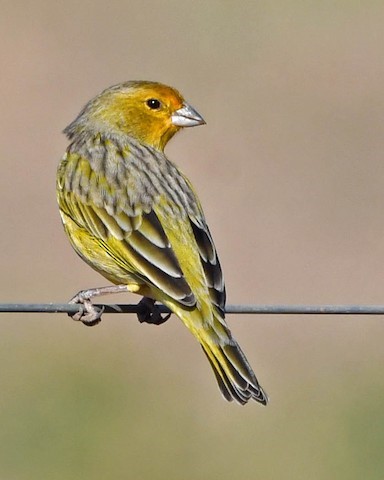
“Pelzeln’s Yellow-Finch”, S. f. koenigi, male showing largely grayish, heavily streaked back, typical of the Andean populations—“Pelzeln’s” varies regionally on a spectrum from Saffron-like yellow in the tropics to gray and heavily streaked in montane and temperate areas. (El Breal, Tarija, Bolivia; July 11, 2021.) © Tini & Jacob Wijpkema

“Pelzeln’s Yellow-Finch”, S. f. pelzelni, male in bright plumage. (Laguna Nahuel Ruca, Mar Chiquita, Buenos Aires, Argentina; October 17, 2020.) © Claudio Rodriguez
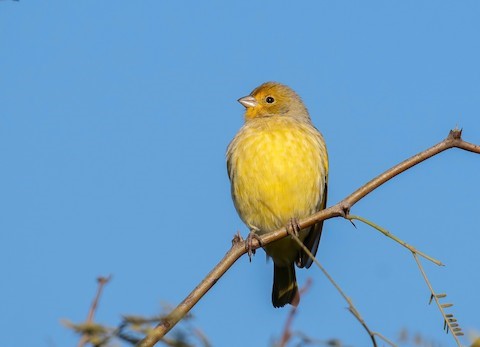
“Pelzeln’s Yellow-Finch”, S. f. pelzelni, male in relatively plain plumage typical of Andean and temperate zone populations. (Las Colonias, Santa Fe, Argentina; May 1, 2021.) © Calidris Esperanza
The latter factor is itself prima facie evidence of genetic exchange over many generations. That is, an obvious candidate explanation for the progression that the adjacent pelzelni populations are more blended with brasiliensis and the more distant ones are progressively more distinct. This in turn would tend to suggest that the two forms were geographically separated for many generations, long enough to diverge substantially through genetic drift, then re-encountered one another soon enough that they readily interbreed and are gradually reintegrating. If this is accurate, then most taxonomists would maintain their current classification as a single species. This consensus seems appropriate, pending the emergence of any potentially conflicting evidence.
Cf. Other Yellow-Finches. Male “Pelzen’s” could be mistaken for male Grassland Yellow-Finch, female Greenish Yellow-Finch, and either sex of Stripe-tailed Yellow-Finch, all of which also have olive backs with darker streaks. “Pelzeln’s” overlaps with Grassland over much of its range in the lowlands from Bolivia southward; it overlaps with Greenish in the Andes of Bolivia and northwestern Argentina; and it overlaps with Stripe-tailed locally in central and southern Brazil and northern Argentina.
In areas where they may occur together these yellow-finches are usually distinguishable by the color patterns of their heads: male “Pelzeln’s” is normally yellow-olive overall with some orange in the face; male Grassland’s face is mostly dull-olive with contrasting pale yellow throat, brow, lore, and eyering; female Greenish’s is dull-olive with a darker, faintly streaked crown; male Stripe-tailed’s is olive with a pale yellow throat and forecrown; and female Stripe-tailed’s is dull-olive with a darker, faintly streaked crown (like female Greenish). Stripe-tailed also has diagnostic white stripes on its tail feathers, visible when it flies or flares its tail.
Additional Photos of “Pelzeln’s Yellow-Finch”

“Pelzeln’s Yellow-Finch”, S. f. koenigi, male. (Pucará, Jujuy, Argentina; August 26, 2014.) © Jorge La Grotteria

“Pelzeln’s Yellow-Finch”, S. f. pelzelni, male. (Costanera Sur Ecological Reserve, Buenos Aires, Argentina; January 24, 2018.) © J. Simón Tagtachian

“Pelzeln’s Yellow-Finch”, S. f. pelzelni, male. (Puerto Varas, Los Lagos, Chile; October 27, 2017.) © Charly Moreno Taucare
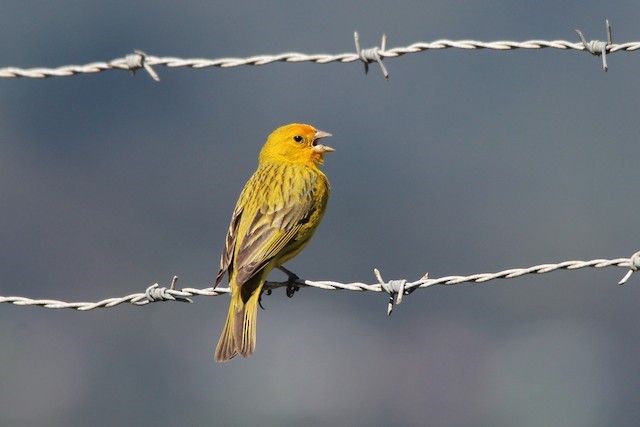
“Pelzeln’s Yellow-Finch”, S. f. pelzelni, male. (Morro de Arena Gruesa, Los Lagos, Chile; November 27, 2017.) © Michael Weymann

“Pelzeln’s Yellow-Finch”, S. f. pelzelni, male. (Costanera Sur Ecological Reserve, Buenos Aires, Argentina; June 14, 2018.) © J. Simón Tagtachian

“Pelzeln’s Yellow-Finch”, S. f. koenigi, female. (Villa de Yotala, Chuquisaca, Bolivia; June 23, 2019.) © Jay McGowan
References
Aves de Chile. 2021. Chirihue Azafrán. https://www.avesdechile.cl/480.htm. (Accessed September 17, 2021.)
BirdLife International. 2018. Sicalis flaveola. The IUCN Red List of Threatened Species 2018: e.T22723346A132162254. https://dx.doi.org/10.2305/IUCN.UK.2018-2.RLTS.T22723346A132162254.en. (Accessed September 17, 2021.)
de la Peña, M.R., and M. Rumboll. 1998. Birds of Southern South America and Antarctica. Princeton University Press.
eBird. 2021. eBird: An online database of bird distribution and abundance. Cornell Lab of Ornithology, Ithaca, N.Y. http://www.ebird.org. (Accessed September 16, 2021.)
Ridgely, R.S., and G. Tudor. 1989. The Birds of South America, Volume I: The Oscine Passerines. University of Texas Press, Austin.
Ridgely, R.S., and G. Tudor. 2009. Field Guide to the Songbirds of South America: The Passerines. University of Texas Press.
van Perlo, B. 2009. A Field Guide to the Birds of Brazil. Oxford University Press, Oxford.
Wikiaves. 2021. Canário da Terra, http://www.wikiaves.com.br/canario-da-terra. (Accessed September 17, 2021.)
Xeno-Canto. 2021. Saffron Finch – Sicalis flaveola. https://www.xeno-canto.org/species/Sicalis-flaveola. (Accessed September 17, 2021.)
